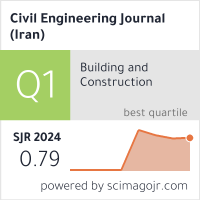Gray Correlation Coefficient Analysis on the Mechanical Properties of Nylon Fiber Reinforced Recycled Aggregate Concrete with GGBS
Downloads
Doi:10.28991/CEJ-2025-011-03-07
Full Text:PDF
Downloads
[2] Islam, Sk. R., Majumder, S. N., & Mutsuddy, R. (2024). Life cycle assessment and mechanical strength of cement composites with conventional, and recycled fine aggregate. Sustainable Structures, 4(2), 52. doi:10.54113/j.sust.2024.000052.
[3] Wilburn, D. R., & Goonan, T. G. (1998). Aggregates from natural and recycled sources; economic assessments for construction applications; a materials flow study. U.S. Department of the Interior, U.S. Geological Survey, Reston, United States. doi:10.3133/cir1176.
[4] McNeil, K., & Kang, T. H. K. (2013). Recycled Concrete Aggregates: A Review. International Journal of Concrete Structures and Materials, 7(1), 61–69. doi:10.1007/s40069-013-0032-5.
[5] Ittyeipe, A. V., Thomas, A. V., & Ramaswamy, K. P. (2020). Comparison of the energy consumption in the production of natural and recycled concrete aggregate: A case study in Kerala, India. IOP Conference Series: Materials Science and Engineering, 989(1). doi:10.1088/1757-899X/989/1/012011.
[6] Freedonia Group. (2012). Global Demand for Construction Aggregates to Exceed 48 Billion Metric Tons in 2015. Concrete Construction, Zonda Media, Washington, United States.
[7] Salman, D. M. (2017). Egypt: Is it a curse or a blessing? International Journal of Green Economics, 11(1), 41–61. doi:10.1504/IJGE.2017.082713.
[8] Adesina, A. (2018). Overview of the mechanical properties of concrete incorporating waste from the concrete industry as aggregate. Concordia University, Montreal, Canada.
[9] Etxeberria, M., Marí, A. R., & Vázquez, E. (2007). Recycled aggregate concrete as structural material. Materials and Structures / Materiaux et Constructions, 40(5), 529–541. doi:10.1617/s11527-006-9161-5.
[10] Mohammed, T. U., Hasnat, A., Awal, M. A., & Bosunia, S. Z. (2015). Recycling of Brick Aggregate Concrete as Coarse Aggregate. Journal of Materials in Civil Engineering, 27(7), 4014005. doi:10.1061/(asce)mt.1943-5533.0001043.
[11] Xiao, J. Z., Li, J. B., & Zhang, C. (2006). On relationships between the mechanical properties of recycled aggregate concrete: An overview. Materials and Structures/Materiaux et Constructions, 39(6), 655–664. doi:10.1617/s11527-006-9093-0.
[12] Danish, A., & Mosaberpanah, M. A. (2022). A review on recycled concrete aggregates (RCA) characteristics to promote RCA utilization in developing sustainable recycled aggregate concrete (RAC). European Journal of Environmental and Civil Engineering, 26(13), 6505–6539. doi:10.1080/19648189.2021.1946721.
[13] Rahal, K. (2007). Mechanical properties of concrete with recycled coarse aggregate. Building and Environment, 42(1), 407–415. doi:10.1016/j.buildenv.2005.07.033.
[14] Etxeberria, M., Vázquez, E., Marí, A., & Barra, M. (2007). Influence of amount of recycled coarse aggregates and production process on properties of recycled aggregate concrete. Cement and Concrete Research, 37(5), 735–742. doi:10.1016/j.cemconres.2007.02.002.
[15] Tam, V. W. Y., Soomro, M., & Evangelista, A. C. J. (2021). Quality improvement of recycled concrete aggregate by removal of residual mortar: A comprehensive review of approaches adopted. Construction and Building Materials, 288, 123066. doi:10.1016/j.conbuildmat.2021.123066.
[16] B. Muhit, I., Haque, S., & Rabiul Alam, M. (2013). Influence of Crushed Coarse Aggregates on Properties of Concrete. American Journal of Civil Engineering and Architecture, 1(5), 103–106. doi:10.12691/ajcea-1-5-3.
[17] Abd Elhakam, A., Mohamed, A. E., & Awad, E. (2012). Influence of self-healing, mixing method and adding silica fume on mechanical properties of recycled aggregates concrete. Construction and Building Materials, 35, 421–427. doi:10.1016/j.conbuildmat.2012.04.013.
[18] Chin, C. S., & Xiao, R. Y. (2013). Flexural toughness of concrete with high performance polymers. Advanced Materials Research, 687, 480–484. doi:10.4028/www.scientific.net/AMR.687.480.
[19] Sato, R., Maruyama, I., Sogabe, T., & Sogo, M. (2007). Flexural behavior of reinforced recycled concrete beams. Journal of Advanced Concrete Technology, 5(1), 43–61. doi:10.3151/jact.5.43.
[20] Arezoumandi, M., Smith, A., Volz, J. S., & Khayat, K. H. (2015). An experimental study on flexural strength of reinforced concrete beams with 100% recycled concrete aggregate. Engineering Structures, 88, 154–162. doi:10.1016/j.engstruct.2015.01.043.
[21] Yang, I. H., Park, J., Kim, K. C., & Lee, H. (2020). Structural Behavior of Concrete Beams Containing Recycled Coarse Aggregates under Flexure. Advances in Materials Science and Engineering, 2020, 8037131. doi:10.1155/2020/8037131.
[22] Tabsh, S. W., & Abdelfatah, A. S. (2009). Influence of recycled concrete aggregates on strength properties of concrete. Construction and Building Materials, 23(2), 1163–1167. doi:10.1016/j.conbuildmat.2008.06.007.
[23] Samson, D., Abdullahi, M., & Mohammed, A. (2016). Effect of Metakaolin on Compressive Strength of Concrete Containing Glass Powder. International Journal of Research in Engineering and Technology, 5(12), 137–142. doi:10.15623/ijret.2016.0512026.
[24] Jayalakshmi Sasidharan Nair, & Basil Johny. (2016). Study of Properties of Concrete using GGBS and Recycled Concrete Aggregates. International Journal of Engineering Research And, V5(09), 160–166. doi:10.17577/ijertv5is090184.
[25] Yehia, S., Helal, K., Abusharkh, A., Zaher, A., & Istaitiyeh, H. (2015). Strength and Durability Evaluation of Recycled Aggregate Concrete. International Journal of Concrete Structures and Materials, 9(2), 219–239. doi:10.1007/s40069-015-0100-0.
[26] Pramod, A. V., Parashivamurthy, P., Yogananda, M. R., & Srishaila, J. M. (2018). Combined effect of GGBS and fly ash on mechanical properties of M25 grade concrete made with recycled fine aggregate. International journal of civil engineering and technology, 9, 1048-1058.
[27] El-Hawary, M., Al-Yaqout, A., & Elsayed, K. (2021). Freezing and thawing cycles: effect on recycled aggregate concrete including slag. International Journal of Sustainable Engineering, 14(4), 800–808. doi:10.1080/19397038.2021.1886374.
[28] Neville, A. M. (2011). Properties of concrete fifth edition. Green technology an A-to-Z guide. SAGE Publication, Thousand Oaks, United States.
[29] Bostanci, S. C., Limbachiya, M., & Kew, H. (2018). Use of recycled aggregates for low carbon and cost effective concrete construction. Journal of Cleaner Production, 189, 176–196. doi:10.1016/j.jclepro.2018.04.090.
[30] Onn, C. C., Mo, K. H., Radwan, M. K. H., Liew, W. H., Ng, C. G., & Yusoff, S. (2019). Strength, carbon footprint and cost considerations of mortar blends with high volume ground granulated blast furnace slag. Sustainability (Switzerland), 11(24), 7194. doi:10.3390/SU11247194.
[31] Song, Q., Shen, B., & Zhou, Z. (2011). Effect of blast furnace slag and steel slag on cement strength, pore structure and autoclave expansion. Advanced Materials Research, 168–170, 17–20. doi:10.4028/www.scientific.net/AMR.168-170.17.
[32] Deepa, P. R., & Anup, J. (2016). Experimental Study on the Effect of Recycled Aggregate and GGBS on Flexural Behaviour of Reinforced Concrete Beam. Applied Mechanics and Materials, 857, 101–106. doi:10.4028/www.scientific.net/amm.857.101.
[33] Mark, O. G., Ede, A. N., Olofinnade, O., Bamigboye, G., Okeke, C., Oyebisi, S. O., & Arum, C. (2019). Influence of Some Selected Supplementary Cementitious Materials on Workability and Compressive Strength of Concrete - A Review. IOP Conference Series: Materials Science and Engineering, 640(1), 12071. doi:10.1088/1757-899X/640/1/012071.
[34] Samad, S., Shah, A., & Limbachiya, M. C. (2017). Strength development characteristics of concrete produced with blended cement using ground granulated blast furnace slag (GGBS) under various curing conditions. Sādhanā, 42(7), 1203–1213. doi:10.1007/s12046-017-0667-z.
[35] Rughooputh, R., & Rana, J. (2014). Partial replacement of cement by ground granulated blast furnace slag in concrete. Journal of Emerging Trends in Engineering and Applied Sciences, 5(5), 340-343.
[36] Jonalagadda, K. B., Kumar Jagarapu, D. C., & Eluru, A. (2020). Experimental study on mechanical properties of supplementary cementitious materials. Materials Today: Proceedings, 27, 1099–1103. doi:10.1016/j.matpr.2020.01.474.
[37] Mo, K. H., Alengaram, U. J., Jumaat, M. Z., Liu, M. Y. J., & Lim, J. (2016). Assessing some durability properties of sustainable lightweight oil palm shell concrete incorporating slag and manufactured sand. Journal of cleaner production, 112, 763-770. doi:10.1016/j.jclepro.2015.06.122.
[38] Korde, C., Cruickshank, M., West, R. P., & Pellegrino, C. (2019). Activated slag as partial replacement of cement mortars: Effect of temperature and a novel admixture. Construction and Building Materials, 216, 506-524. doi:10.1016/j.conbuildmat.2019.04.172.
[39] Jaldhari, E. R., & Nagar, B. (2017). Performance of recycled aggregates using GGBS” an experimental study. International Research Journal of Engineering and Technology, 4(6), 2735-2738.
[40] Zhang, P., Han, S., Ng, S., & Wang, X. H. (2018). Fiber-Reinforced Concrete with Application in Civil Engineering. Advances in Civil Engineering, 1698905. doi:10.1155/2018/1698905.
[41] Najafiyan, M., Bagheri, Z., Ghasemi, A., & Rashnavadi, A. (2013). Comparison study on concretes containing fibers to provide concrete with high resistance. World Applied Sciences Journal, 24(8), 1106–1110. doi:10.5829/idosi.wasj.2013.24.08.1301.
[42] Rao, K. S., & Narayana, S. R. K. A. L. (2013). Comparison of performance of standard concrete and fibre reinforced standard concrete exposed to elevated temperatures. American Journal of Engineering Research, 2(3), 20-26.
[43] Ghaffar, A., S. Chavhan, A., & Tatwawadi, Dr. R. S. (2014). Steel Fibre Reinforced Concrete. International Journal of Engineering Trends and Technology, 9(15), 791–797. doi:10.14445/22315381/ijett-v9p349.
[44] Ragavendra, S., Reddy, I. P., & Dongre, A. R. C. H. A. N. A. A. (2017). Fibre reinforced concrete-A case study. Proceedings of the Architectural Engineering Aspect for Sustainable Building Envelopes, Hyderabad, India.
[45] Choudhary, V. (2017). A research paper on the performance of synthetic fibre reinforced concrete. International Research Journal of Engineering and Technology, 12(4), 1661-1663.
[46] Choi, Y., & Yuan, R. L. (2005). Experimental relationship between splitting tensile strength and compressive strength of GFRC and PFRC. Cement and Concrete Research, 35(8), 1587–1591. doi:10.1016/j.cemconres.2004.09.010.
[47] Swami, A., & Gupta, S. (2016). Use of nylon fiber in concrete. IJSRD-International Journal for Scientific Research & Development, 4(5), 2321-0613.
[48] Song, P. S., Hwang, S., & Sheu, B. C. (2005). Strength properties of nylon- and polypropylene-fiber-reinforced concretes. Cement and Concrete Research, 35(8), 1546–1550. doi:10.1016/j.cemconres.2004.06.033.
[49] Ummahat, N. (2019). Effect of nylon fiber aspect ratio on the mechanical properties of fiber reinforced concrete. Master Thesis, Bangladesh University of Engineering and Technology (BUET), Dhaka, Bangladesh.
[50] Hossain, M. A., Rahman, M. M., Morshed, A. Z., & Haque, S. K. M. (2012). Investigation of the effect of nylon fiber in concrete rehabilitation. Proceedings of the 1st International Conference on Civil Engineering for Sustainable Development (ICCESD-2012), 2-3 March, 2012, Khulna, Bangladesh.
[51] Joshi, A., Reddy, P., Kumar, P., & Hatker, P. (2016). Experimental work on steel fibre reinforced concrete International Journal of Scientific & Engineering Research, 7(10), 971-981.
[52] Lee, S. (2019). Effect of nylon fiber addition on the performance of recycled aggregate concrete. Applied Sciences (Switzerland), 9(4), 767. doi:10.3390/app9040767.
[53] Ahmad, J., Zaid, O., Pérez, C. L. C., Martínez-García, R., & López-Gayarre, F. (2022). Experimental Research on Mechanical and Permeability Properties of Nylon Fiber Reinforced Recycled Aggregate Concrete with Mineral Admixture. Applied Sciences (Switzerland), 12(2), 554. doi:10.3390/app12020554.
[54] Gupta, N., & Rashid, M. (2020). A Review of Ggbs and Steel Fibre Performance in High Performance Concrete. International Journal of Scientific Research & Engineering Trends, 6(4), 2540–2544.
[55] Peddi Raju, A., & B.S. Dadapeer, A. (2017). Effect of GGBS on Fiber Reinforced Concrete. International Journal of Scientific Research in Science and Technology, 3(2), 616–626.
[56] Bhosale, P. A., & Kawade, U. R. (2015). Effect of Recron 3s Fibers on GGBS Replaced Cement Concrete. International Journal of Science and Research (IJSR), 4(9), 335–344.
[57] Zoe, Y., Hanif, I. M., Adzmier, H. M., Eyzati, H. H., & Noor Syuhaili, M. R. (2020). Strength of Self-Compacting Concrete Containing Metakaolin and Nylon Fiber. IOP Conference Series: Earth and Environmental Science, 498(1), 12047. doi:10.1088/1755-1315/498/1/012047.
[58] Saxena, J., & Saxena, A. (2015). Enhancement the strength of conventional concrete by using nylon fibre. Research Inventy: International Journal of Engineering and Science, 5(2), 56-59.
[59] Qureshi, L. A., Ali, B., & Ali, A. (2020). Combined effects of supplementary cementitious materials (silica fume, GGBS, fly ash and rice husk ash) and steel fiber on the hardened properties of recycled aggregate concrete. Construction and Building Materials, 263, 120636. doi:10.1016/j.conbuildmat.2020.120636.
[60] Zaid, O., Althoey, F., García, R. M., de Prado-Gil, J., Alsulamy, S., & Abuhussain, M. A. (2023). A study on the strength and durability characteristics of fiber-reinforced recycled aggregate concrete modified with supplementary cementitious material. Heliyon, 9(9), e19978. doi:10.1016/j.heliyon.2023.e19978.
[61] Ahmad, J., Martínez-García, R., Szelag, M., De-Prado-Gil, J., Marzouki, R., Alqurashi, M., & Hussein, E. E. (2021). Effects of steel fibers (Sf) and ground granulated blast furnace slag (GGBS) on recycled aggregate concrete. Materials, 14(24), 7497. doi:10.3390/ma14247497.
[62] Zheng, Y., Zhuo, J., Zhang, Y., & Zhang, P. (2022). Mechanical properties and microstructure of nano-SiO2and basalt-fiber-reinforced recycled aggregate concrete. Nanotechnology Reviews, 11(1), 2169–2189. doi:10.1515/ntrev-2022-0134.
[63] Amir, M. T., Riaz, S., Ahmed, H., Raza, S. S., Shohan, A. A. A., & Alsulamy, S. (2023). Synergistic Effect of Micro-Silica and Recycled Tyre Steel Fiber on the Properties of High-Performance Recycled Aggregate Concrete. Sustainability (Switzerland), 15(11), 8642. doi:10.3390/su15118642.
[64] Raza, S. S., Fahad, M., Ali, B., Amir, M. T., Alashker, Y., & Elhag, A. B. (2022). Enhancing the Performance of Recycled Aggregate Concrete Using Micro-Carbon Fiber and Secondary Binding Material. Sustainability (Switzerland), 14(21), 14613. doi:10.3390/su142114613.
[65] Benemaran, R. S., Esmaeili-Falak, M., & Kordlar, M. S. (2024). Improvement of recycled aggregate concrete using glass fiber and silica fume. Multiscale and Multidisciplinary Modeling, Experiments and Design, 7(3), 1895–1914. doi:10.1007/s41939-023-00313-2.
[66] Kumar, P., Gogineni, A., & Upadhyay, R. (2024). Mechanical performance of fiber-reinforced concrete incorporating rice husk ash and recycled aggregates. Journal of Building Pathology and Rehabilitation, 9(2), 1–11. doi:10.1007/s41024-024-00500-9.
[67] Gong, S., Bai, L., Tan, Z., Xu, L., Bai, X., & Huang, Z. (2023). Mechanical Properties of Polypropylene Fiber Recycled Brick Aggregate Concrete and Its Influencing Factors by Gray Correlation Analysis. Sustainability (Switzerland), 15(14), 11135. doi:10.3390/su151411135.
[68] ASTM C136/C136M-19. (2020). Standard Test Method for Sieve Analysis of Fine and Coarse Aggregates. ASTM International, Pennsylvania, United States. doi:10.1520/C0136_C0136M-19.
[69] ACI 2011.1-91. (2002). Standard Practice for Selecting Proportions for Normal, Heavyweight, and Mass Concrete. American Concrete Institute (ACI), Farmington Hills, United States.
[70] Saha, A. S., & Amanat, K. M. (2021). Rebound hammer test to predict in-situ strength of concrete using recycled concrete aggregates, brick chips and stone chips. Construction and Building Materials, 268, 121088. doi:10.1016/j.conbuildmat.2020.121088.
[71] MaleŠ¡ev, M., Radonjanin, V., & Marinković, S. (2010). Recycled concrete as aggregate for structural concrete production. Sustainability, 2(5), 1204–1225. doi:10.3390/su2051204.
[72] ASTM C192/C192M-16a. (2016). Standard Practice for Making and Curing Concrete Test Specimens in the Laboratory. ASTM International, Pennsylvania, United States. doi:10.1520/C0192_C0192M-16A.
[73] Wu, B., Liu, C., & Wu, Y. (2014). Compressive behaviors of cylindrical concrete specimens made of demolished concrete blocks and fresh concrete. Construction and Building Materials, 53, 118-130. doi:10.1016/j.conbuildmat.2013.11.071.
[74] ASTM C39/C39M-21. (2023). Standard Test Method for Compressive Strength of Cylindrical Concrete Specimens. ASTM International, Pennsylvania, United States. doi:10.1520/C0039_C0039M-21.
[75] ASTM C496/C496M-17. (2017). Standard Test Method for Splitting Tensile Strength of Cylindrical Concrete Specimens. ASTM International, Pennsylvania, United States. doi:10.1520/C0496_C0496M-17.
[76] ASTM C78/C78M-18. (2021). Standard Test Method for Flexural Strength of Concrete (Using Simple Beam with Third-Point Loading). ASTM International, Pennsylvania, United States. doi:10.1520/C0078_C0078M-18.
[77] ASTM C1609/C1609M-19a. (2024). Standard Test Method for Flexural Performance of Fiber-Reinforced Concrete (Using Beam With Third-Point Loading). ASTM International, Pennsylvania, United States. doi:10.1520/C1609_C1609M-19A.
[78] Zhang, Y., & Zhang, X. (2007). Grey correlation analysis between strength of slag cement and particle fractions of slag powder. Cement and Concrete Composites, 29(6), 498–504. doi:10.1016/j.cemconcomp.2007.02.004.
[79] Liu, J., & Liang, B. (2009). Grey correlation analysis of sensitive factors of concrete structures durability. Key Engineering Materials, 400–402, 471–476. doi:10.4028/www.scientific.net/kem.400-402.471.
[80] Thomas, J., Thaickavil, N. N., & Wilson, P. M. (2018). Strength and durability of concrete containing recycled concrete aggregates. Journal of Building Engineering, 19, 349–365. doi:10.1016/j.jobe.2018.05.007.
[81] Oner, A., & Akyuz, S. (2007). An experimental study on optimum usage of GGBS for the compressive strength of concrete. Cement and Concrete Composites, 29(6), 505–514. doi:10.1016/j.cemconcomp.2007.01.001.
[82] Munjal, P., Hau, K. K., & Hon Arthur, C. C. (2021). Effect of GGBS and curing conditions on strength and microstructure properties of oil well cement slurry. Journal of Building Engineering, 40, 102331. doi:10.1016/j.jobe.2021.102331.
[83] Spadea, S., Farina, I., Carrafiello, A., & Fraternali, F. (2015). Recycled nylon fibers as cement mortar reinforcement. Construction and Building Materials, 80, 200–209. doi:10.1016/j.conbuildmat.2015.01.075.
[84] Campello, E., Pereira, M. V., & Darwish, F. (2014). The Effect of Short Metallic and Polymeric Fiber on the Fracture Behavior of Cement Mortar. Procedia Materials Science, 3, 1914–1921. doi:10.1016/j.mspro.2014.06.309.
- Authors retain all copyrights. It is noticeable that authors will not be forced to sign any copyright transfer agreements.
- This work (including HTML and PDF Files) is licensed under a Creative Commons Attribution 4.0 International License.![]()















